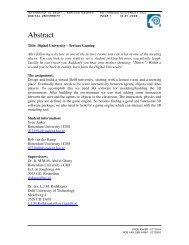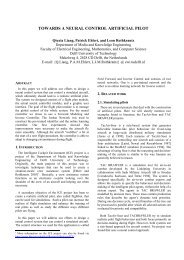Recognition of facial expressions - Knowledge Based Systems ...
Recognition of facial expressions - Knowledge Based Systems ...
Recognition of facial expressions - Knowledge Based Systems ...
You also want an ePaper? Increase the reach of your titles
YUMPU automatically turns print PDFs into web optimized ePapers that Google loves.
Several researchers have developed probabilistic inference algorithms for Bayesian<br />
networks with discrete variables that exploit conditional independence. Pearl (1986)<br />
developed a message-passing scheme that updates the probability distributions for each<br />
node in a Bayesian network in response to observations <strong>of</strong> one or more variables.<br />
Lauritzen and Spiegelhalter (1988), Jensen et al. (1990), and Dawid (1992) created an<br />
algorithm that first transforms the Bayesian network into a tree where each node in the<br />
tree corresponds to a subset <strong>of</strong> variables in X. The algorithm then exploits several<br />
mathematical properties <strong>of</strong> this tree to perform probabilistic inference.<br />
The most commonly used algorithm for discrete variables is that <strong>of</strong> Lauritzen and<br />
Spiegelhalter (1988), Jensen et al (1990), and Dawid (1992). Methods for exact inference<br />
in Bayesian networks that encode multivariate-Gaussian or Gaussianmixture distributions<br />
have been developed by Shachter and Kenley (1989) and Lauritzen (1992), respectively.<br />
Approximate methods for inference in Bayesian networks with other distributions, such<br />
as the generalized linear-regression model, have also been developed (Saul et al., 1996;<br />
Jaakkola and Jordan, 1996). For those applications where generic inference methods are<br />
impractical, researchers are developing techniques that are custom tailored to particular<br />
network topologies (Heckerman 1989; Suermondt and Cooper, 1991; Saul et al., 1996;<br />
Jaakkola and Jordan, 1996) or to particular inference queries (Ramamurthi and Agogino,<br />
1988; Shachter et al., 1990; Jensen and Andersen, 1990; Darwiche and Provan, 1996).<br />
Gradient Ascent for Bayes Nets<br />
If wijk<br />
denote one entry in the conditional probability table for variable Y<br />
i<br />
in the network,<br />
then:<br />
w<br />
ijk<br />
= P(Yi = yij<br />
| Parents(Y<br />
i<br />
) = thelist u<br />
ik<br />
<strong>of</strong><br />
values)<br />
Perform gradient ascent by repeatedly performing:<br />
- update all wijk<br />
using training data D<br />
w<br />
ijk<br />
← w<br />
ijk<br />
+ η<br />
d∈D<br />
P<br />
h<br />
( yij,uik<br />
w<br />
ijk<br />
| d)<br />
- 37 -
















